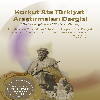13B Wankel Motorunda Ateşleme Avansının Yanma, Yakıt Tüketimi ve Emisyona Etkileri
Bu çalışmada, optimum avans, 10 derece EMA altı ve 10 derece EMA üstü avanslarda özgül yakıt tüketimi, emisyonlar, silindir içi basınç ve ısı salımı oranları gibi parametreler incelenmiştir. Motor olarak deneyde 13B-MSP tek rotorlu ve manifolda püskürtmeli bir Wankel motor kullanılmıştır. Bu kapsamda, tek rotorlu Wankel deney motoru 2000, 3000 ve 4000 dev/dak motor hızında, kısmi yüklerde ve λ=1 koşulunda çalıştırılmıştır. Optimum ateşleme avansı maksimum momentin elde edildiği değer baz alınmıştır. Böylece, ateşleme avansının Wankel motordaki etkisi incelenmiştir. Sonuç olarak ateşleme avansının Wankel motorda emisyonlar, silindir içi basınç ve yakıt tüketimi üzerinde büyük bir etkiye sahip olduğu gözlenmiştir.
EFFECTS OF IGNITION ADVANCE ON COMBUSTION, FUEL CONSUMPTION AND EMISSION AT 13B WANKEL ENGINE
In this study, the optimum advances for parameters such as specific fuelconsumption, emissions were investigated in ignition advances below 100 EA and above 100 EA.Cylinder pressure was measured for calculating the heat release rate. 13B MSP (Multi Side Port)single rotor and port fuel injection Wankel engine was used in the experiments. In this context,single rotor Wankel test engine was operated at 2000, 3000 and 4000 rpm engine speed, part loadsand λ = 1 condition. The optimum ignition advance is based on the value at which the maximumtorque is obtained. Thus, the effect of ignition advance was investigated on Wankel engine. As aresult, it is observed that ignition advance has a significant effect on emissions, in-cylinder pressureand fuel consumption in Wankel engine.
___
- Amrouche, F., Erickson, P.A., Varnhagen, S., Park, J.W., 2018, “An experimental analysis of hydrogen enrichment on combustion characteristics of a gasoline Wankel engine at full load and lean burn regime”, International Journal of Hydrogen Energy, 43(41), pp. 19250- 19259.
- Ansdale R. F., 1968, The Wankel RC Engine, Iliffe Books Ltd., London, England.
- Bensinger W.D., 1973, Rotationskolben-Verbrennungsmotoren, Berlin, Deustche: Springer-Verlag.
- Cihan, Ö., 2017, Experimental and numerical investigation of the Wankel engine and skip cycle system, Doctoral thesis, Istanbul Technical University, Institute of Science and Technology, Istanbul.
- Fan, B., Pan, J., Liu, Y., Zhu, Y., 2015, “Effects of ignition parameters on combustion process of a rotary engine fueled with natural gas”, Energy Conversion and Management, 103, pp. 218-234.
- Finkelberg, L., Kostuchenkov, A., Zelentsov, A., Minin, V., 2019, “Improvement of Combustion Process of Spark-Ignited Aviation Wankel Engine”, Energies, 12(12), 2292, pp. 1-11.
- Froede, W.G., 1961, “The NSU-Wankel rotating combustion engine”, SAE paper, 610017, pp. 179- 203.
- Froede, W.G., 1965, “The Rotary Engine of the NSU Spider”, SAE paper, 650722, pp. 414-436.
- Froede, W.G., 1968, “NSU's Double Bank Production Rotary Engine”, SAE paper, 680461, pp. 1-10.
- Hwang, P.W., Chen, X.C., Cheng, H.C., 2016, “Influences of ignition timing, spark plug and intake port locations on the combustion performance of a simulated rotary engine”, Journal of Mechanics, 32(5), pp. 579-591.
- Iskra, A., Babiak, M., 2007, “Real possibilities of construction of CI Wankel engine”, Jour, pp. 1-6.
- Ji, C., Shi, C., Wang, S., Yang, J., Su, T., Wang, D., 2019, “Effect of dual-spark plug arrangements on ignition and combustion processes of a gasoline rotary engine with hydrogen directinjection enrichment”, Energy Conversion and Management, 181, pp. 372-381.
- Kohno, T., Lto, R., Morita, M., Mizuno, N., 1979, “Analysis of light-load performance in rotary engines”, SAE paper, 790435, pp. 1637-1652.
- Kutlar, O.A., Cihan, Ö., Doğan, H.E., Demirci, A., 2018, “The effect of different intake port geometries of a single - rotor Wankel engine on performance and emissions at part-load conditions”, Journal of The Faculty of Engineering and Architecture of Gazi University, Vol. 33, No. 3, pp. 809-819.
- Ohkubo, M., Tashima, S., Shimizu, R., 2004, “Developed Technologies of the New Rotary Engine (RENESIS)”, SAE technical paper, 2004-01-1790, pp. 1-10.
- Otchere, P., Pan, J., Fan, B., Chen, W., Yao, L., Jianxing, L., 2019, “Numerical investigation of the effect of advance ignition timing on combustion process in direct injection rotary engine fueled with biodiesel”, Sustainable Energy, pp. 1-34.
- Raju, R.S., 1992,. “Heat transfer and performance characteristics of a dual-ignition Wankel engine”, SAE technical paper, 920303, pp. 1-46.
- Shi, C., Ji, C., Wang, S., Yang, J., Li, X., & Ge, Y. 2019a, “Numerical simulation on combustion process of a hydrogen direct-injection stratified gasoline Wankel engine by synchronous and asynchronous ignition modes”, Energy conversion and management, 183, pp. 14-25.
- Shi, C., Ji, C., Ge, Y., Wang, S., Bao, J., Yang, J., 2019b, “Numerical study on ignition amelioration of a hydrogen-enriched Wankel engine under lean-burn condition”, Applied Energy, 255, 113800, pp. 1-12.
- Shi, C., Ji, C., Wang, S., Yang, J., Li, X., Ge, Y., 2019c, “Effects of hydrogen direct-injection angle and charge concentration on gasoline-hydrogen blending lean combustion in a Wankel engine”, Energy Conversion and Management, 187, pp. 316-327.
- Su, T., Ji, C., Wang, S., Shi, L., Cong, X., 2018, “Effect of ignition timing on performance of a hydrogen-enriched n-butanol rotary engine at lean condition”, Energy Conversion and Management, 161, pp. 27–34.
- Warner M., 2009, Street Rotary, Penguin Group, New York, USA.
- Yamamoto K., 1971, Rotary Engine, Toyo Kogyo Co., Ltd., Hiroshima, Japan.
- Yamamoto, K., Muroki, T., Kobayakawa, T., 1972, “Combustion characteristics of rotary engines”, SAE paper, 720357, pp. 1296-1302.
- Yayın Aralığı: Yılda 4 Sayı
- Yayıncı: Konya Teknik Üniversitesi, Mühendislik ve Doğa Bilimleri Fakültesi
Sayıdaki Diğer Makaleler
Ertuğrul ESMERAY, Özlem ARMUTCU
Erdem Selver, Serhat Osmanoğlu, Muharrem İmal
BETONARME KİRİŞLERİN ŞEKİL DEĞİŞTİRME ESASLI HASAR SINIRLARININ ARAŞTIRILMASI
Saeid FOROUGHİ, Rohullah JAMAL, S. Bahadır YÜKSEL
Abdullah YILDIZBASI, Mustafa Burak ÖZDEMİR
İstanbul İlinde Hava Kalitesi İzleme ve Yönetimi için WebGIS Tabanlı Hava Kalite GeoPortalı Tasarımı
Ali DEMİR, Kabil ÇETİN, Taha Yasin ALTIOK
Şeyma KORKMAZ, M. Hüseyin ÇETİN, Muhammed ADAR, Abdulkadir ORAK
13B Wankel Motorunda Ateşleme Avansının Yanma, Yakıt Tüketimi ve Emisyona Etkileri
Osman Akın KUTLAR, Ömer CİHAN, Abdurrahman DEMİRCİ, Hüseyin Emre DOĞAN
AISI 1040 Çeliğinin Kuru ve Islak Koşullarda Delinmesinin Deneysel ve İstatistiksel İncelenmesi
